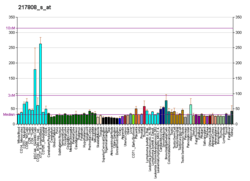MAPKAP1
Target of rapamycin complex 2 subunit MAPKAP1 is a protein that in humans is encoded by the MAPKAP1 gene.[5][6]
This gene encodes a protein that is highly similar to the yeast SIN1 protein, a stress-activated protein kinase. Alternatively spliced transcript variants encoding distinct isoforms have been described. Alternate polyadenylation sites as well as alternate 3' UTRs have been identified for transcripts of this gene.[6]
References
- 1 2 3 GRCh38: Ensembl release 89: ENSG00000119487 - Ensembl, May 2017
- 1 2 3 GRCm38: Ensembl release 89: ENSMUSG00000038696 - Ensembl, May 2017
- ↑ "Human PubMed Reference:".
- ↑ "Mouse PubMed Reference:".
- ↑ Schroder W, Cloonan N, Bushell G, Sculley T (Sep 2004). "Alternative polyadenylation and splicing of mRNAs transcribed from the human Sin1 gene". Gene. 339: 17–23. PMID 15363842. doi:10.1016/j.gene.2004.07.001.
- 1 2 "Entrez Gene: MAPKAP1 mitogen-activated protein kinase associated protein 1".
Further reading
- Colicelli J, Nicolette C, Birchmeier C, et al. (1991). "Expression of three mammalian cDNAs that interfere with RAS function in Saccharomyces cerevisiae". Proc. Natl. Acad. Sci. U.S.A. 88 (7): 2913–7. PMC 51350
 . PMID 1849280. doi:10.1073/pnas.88.7.2913.
. PMID 1849280. doi:10.1073/pnas.88.7.2913. - Strausberg RL, Feingold EA, Grouse LH, et al. (2003). "Generation and initial analysis of more than 15,000 full-length human and mouse cDNA sequences". Proc. Natl. Acad. Sci. U.S.A. 99 (26): 16899–903. PMC 139241
 . PMID 12477932. doi:10.1073/pnas.242603899.
. PMID 12477932. doi:10.1073/pnas.242603899. - Jin J, Smith FD, Stark C, et al. (2004). "Proteomic, functional, and domain-based analysis of in vivo 14-3-3 binding proteins involved in cytoskeletal regulation and cellular organization". Curr. Biol. 14 (16): 1436–50. PMID 15324660. doi:10.1016/j.cub.2004.07.051.
- Gerhard DS, Wagner L, Feingold EA, et al. (2004). "The Status, Quality, and Expansion of the NIH Full-Length cDNA Project: The Mammalian Gene Collection (MGC)". Genome Res. 14 (10B): 2121–7. PMC 528928
 . PMID 15489334. doi:10.1101/gr.2596504.
. PMID 15489334. doi:10.1101/gr.2596504. - Schroder W, Bushell G, Sculley T (2005). "The human stress-activated protein kinase-interacting 1 gene encodes JNK-binding proteins". Cell. Signal. 17 (6): 761–7. PMID 15722200. doi:10.1016/j.cellsig.2004.10.015.
- Benzinger A, Muster N, Koch HB, et al. (2005). "Targeted proteomic analysis of 14-3-3 sigma, a p53 effector commonly silenced in cancer". Mol. Cell Proteomics. 4 (6): 785–95. PMID 15778465. doi:10.1074/mcp.M500021-MCP200.
- Cheng J, Zhang D, Kim K, et al. (2005). "Mip1, an MEKK2-Interacting Protein, Controls MEKK2 Dimerization and Activation". Mol. Cell. Biol. 25 (14): 5955–64. PMC 1168836
 . PMID 15988011. doi:10.1128/MCB.25.14.5955-5964.2005.
. PMID 15988011. doi:10.1128/MCB.25.14.5955-5964.2005. - Venables JP, Bourgeois CF, Dalgliesh C, et al. (2005). "Up-regulation of the ubiquitous alternative splicing factor Tra2beta causes inclusion of a germ cell-specific exon". Hum. Mol. Genet. 14 (16): 2289–303. PMID 16000324. doi:10.1093/hmg/ddi233.
- Rual JF, Venkatesan K, Hao T, et al. (2005). "Towards a proteome-scale map of the human protein-protein interaction network". Nature. 437 (7062): 1173–8. PMID 16189514. doi:10.1038/nature04209.
- Frias MA, Thoreen CC, Jaffe JD, et al. (2006). "mSin1 is necessary for Akt/PKB phosphorylation, and its isoforms define three distinct mTORC2s". Curr. Biol. 16 (18): 1865–70. PMID 16919458. doi:10.1016/j.cub.2006.08.001.
- Jacinto E, Facchinetti V, Liu D, et al. (2006). "SIN1/MIP1 maintains rictor-mTOR complex integrity and regulates Akt phosphorylation and substrate specificity". Cell. 127 (1): 125–37. PMID 16962653. doi:10.1016/j.cell.2006.08.033.
- Yang Q, Inoki K, Ikenoue T, Guan KL (2006). "Identification of Sin1 as an essential TORC2 component required for complex formation and kinase activity". Genes Dev. 20 (20): 2820–32. PMC 1619946
 . PMID 17043309. doi:10.1101/gad.1461206.
. PMID 17043309. doi:10.1101/gad.1461206. - Makino C, Sano Y, Shinagawa T, et al. (2007). "Sin1 binds to both ATF-2 and p38 and enhances ATF-2-dependent transcription in an SAPK signaling pathway". Genes Cells. 11 (11): 1239–51. PMID 17054722. doi:10.1111/j.1365-2443.2006.01016.x.
- Olsen JV, Blagoev B, Gnad F, et al. (2006). "Global, in vivo, and site-specific phosphorylation dynamics in signaling networks". Cell. 127 (3): 635–48. PMID 17081983. doi:10.1016/j.cell.2006.09.026.
- Schroder WA, Buck M, Cloonan N, et al. (2007). "Human Sin1 contains Ras-binding and pleckstrin homology domains and suppresses Ras signalling". Cell. Signal. 19 (6): 1279–89. PMID 17303383. doi:10.1016/j.cellsig.2007.01.013.
This article is issued from
Wikipedia.
The text is licensed under Creative Commons - Attribution - Sharealike.
Additional terms may apply for the media files.




